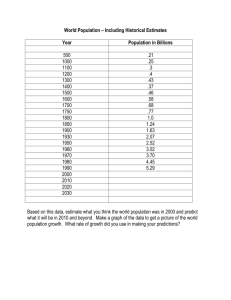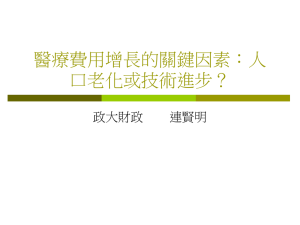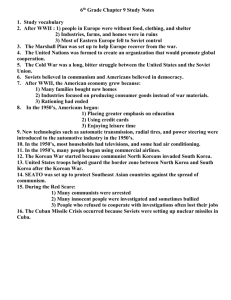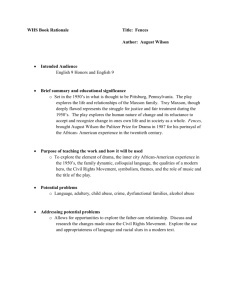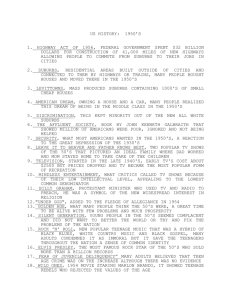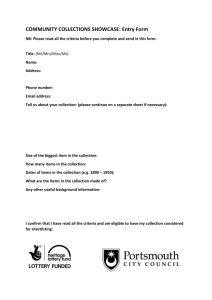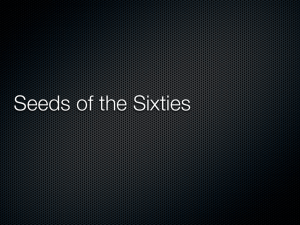America in the 1950s - Strongsville City Schools
advertisement
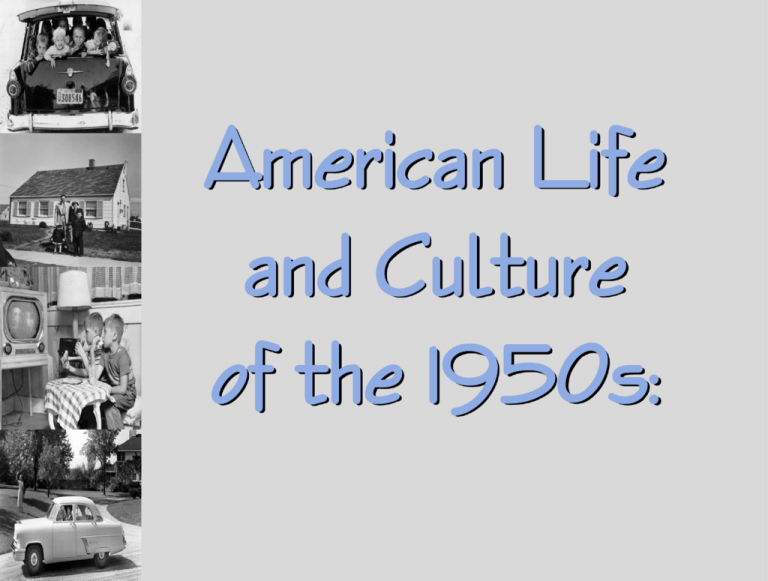
American Life and Culture of the 1950s: Politics Election of 1948: • Harry Truman (Democrat) • Thomas Dewey (Republican) • Strom Thurmond (States Rights Party Dixiecrats) Outcome: Truman Wins! Fair Deal: • Truman’s economic policy • An extension of FDR’s New Deal Politics Election of 1952: • Adlai Stevenson (Democrat) • Dwight D. Eisenhower(Republican) Outcome: • Eisenhower wins! • Modern Republicanism Changes to the Family Cause: • Gender Roles Cause Conflict • Tradition Men Work & Women Stay at Home Effect: • High Divorce Rate • Women Challenge Traditional Gender Roles The Baby Boom Cause: • By 1946, 10 million men and women have returned home from active duty and released from the armed forces. Effect: • Baby Boom: increase in American births resulting in a U.S. population explosion “It seems to me that every other young housewife I see is pregnant”. -- British visitor to America, 1958 Ex: 1957 1 baby born every 7 seconds Dr. Benjamin Spock: • author of Common Sense Book of Baby & Child Care • parents used as guide to raise their children Dr. Jonas Salk: developed a vaccine for polio Effects on Schools: • Increase in school enrollment • Overcrowding in Schools • Teacher Shortages Suburban Living Issue: Solution: • Returning veterans • Mass Produced Housing face housing shortage • Built in the Suburbs • Ex: Levitttown on Long Island $7,990 or $60/month with no down payment. SHIFTS IN POPULATION DISTRIBUTION, 1940-1970 Central Cities Suburbs Rural Areas/ Small Towns 1940 31.6% 19.5% 48.9% 1950 32.3% 23.8% 43.9% 1960 32.6% 30.7% 36.7% 1970 32.0% 41.6% 26.4% - Source: U. S. Bureau of the Census Americans Hit the Road • In the 1950’s Americans buy cars in record numbers • Suburban living required cars for mobility Outcomes: • Interstate Highway Act (1956): authorized the creation of a nationwide highway network • Rise in family vacations (national parks, amusement parks, historic sites, etc.) Led to the establishment of: The Drive Thru Freedom for Teens The Drive-In Movie Family Vacations Consumerism Consumerism: the buying of material goods Cause: • By mid 1960’s 60% of Americans were part of the “middle class” • Buying consumer goods = success Effect: • New products hit the market place All babies were potential consumers who spearheaded a brand-new market for food, clothing, and shelter. -- Life Magazine (May, 1958) Planned Obsolescence: • Marketing strategy in which manufacturers design products to become outdated in a short amount of time to encourage consumers to purchase the newest design Examples: • cars • televisions • washing machines • kitchen appliances Advertising Age: • Billboards, Newspapers, Magazines, Radio, Television, and Catalogs • Appeal to people’s desire for status to buy things they didn’t really need A Changing Workplace Cause Automation • 1947-1957 factory workers decrease blue-collar jobs eliminated • By 1956 more white-collar than blue-collar jobs in the U. S. Ex: Computers 1st IBM mainframe computer (1951) New Corporate Culture: - The Company Man: The 1950’s: Mass Culture • The 1950’s is the beginning of modern day “pop culture” • Mass Culture: culture that is widely spread via mass media (radio, magazines, newspaper, and starting in the 1950’s……… Television 1946 7,000 TV sets in the U. S. 1950 50,000,000 TV sets in the U. S. The 1950’s is called the “Golden Age of Television” TV celebrated traditional American values. Truth, Justice, and the American way! The Typical TV Suburban Families TV portrayed stereotypes of the family, women, and minorities The Donna Reed Show 1958-1966 Father Knows Best 1954-1958 Leave It to Beaver 1957-1963 The Ozzie & Harriet Show 1952-1966 Television - Family Shows Glossy view of mostly middle-class white suburban life I Love Lucy The Honeymooners Television – The Western Davy Crockett King of the Wild Frontier Sheriff Matt Dillon, Gunsmoke The Lone Ranger (and his faithful sidekick, Tonto): 1950’s Movies 1954: Rear Window by Alfred Hitchcock 1951: The Day the Earth Stood Still (Golden Age of Sci-Fi) 1956: Ten Commandments starring Charlton Heston 1951: A Streetcar Named Desire starring Marlon Brando 1959: Ben Hur wins 11 Academy Awards 1950’s Music Rock ‘n’ Roll: • Form of American music that began in the 1950’s & is a mixture of rhythm & blues, country, jazz, gospel, and pop • Term coined by Alan Freed a Cleveland, OH radio disc jockey in 1951 Rock n Roll Musicians Elvis Presley Chuck Berry Bill Haley & the Comets Buddy Holly Little Richard Teen Culture In the 1950s the word “teenager” entered the American language. Causes: • Booming economy allowed students to stay in school vs. work to support family • Business's target this new consumer group Juvenile Rebellion J. D. Salinger’s A Catcher in the Rye (1951) 1950’s Advertisement James Dean in Rebel Without a Cause (1955) Marlon Brando in The Wild One (1953) 1950’s Cultural Norms • Obey Authority. • Control Your Emotions. • Don’t Make Waves Fit in with the Group. • Don’t Even Think About Sex!!! 1950’s Counterculture Beat Movement: • Social & artistic movement stressing unrestrained literary expression and non-conformity with 1950’s mainstream culture “Beatnik” “Clean” Teen • Centered in San Francisco, L.A., and NYC • Artists, Poets, & Writers • Nicknamed “Beatniks” Religious Revival Church membership: 1940 64,000,000 1960 114,000,000 Bishop Fulton Sheen Reverend Billy Graham Minister Norman Vincent Peale Today in the U. S., the Christian faith is back in the center of things. -- Time magazine, 1954
